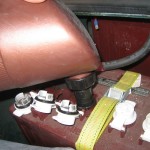Every month or so, it’s time to water my lead acid batteries. It’s not particularly difficult to do this maintenance. It’s not even dirty. But, it does take about 30 minutes.
Lead acid batteries have an electrolyte of sulfuric acid. The chemistry between the lead and acid stores and releases the electricity that makes the vehicle go. The chemistry is simple on the surface, but very difficult in reality. I’m not going to pretend to have any insight into how it really works. What I do know is that during the final step of the charging sequence water is broken down into hydrogen and oxygen. The charger overcharges most of the batteries while waiting for the last few straggler cells to reach full voltage. Lead acid batteries are fine with this, as it’s easy to replace the water, and it does no harm to the batteries in the long run. Lithium batteries on the other hand can easily be killed by overcharging them. Voltage monitoring hardware is usually needed to keep such a situation from occurring.
Each 12 volt battery has 6 cells, that each sit at about 2.13 volts while charged up. Since I have 10 batteries, that means there are 60 cells to top off with water. The first thing I do is make sure I have enough distilled water. I use about 1.5 gallons per watering session, depending on how much charging I’ve done between waterings. I use a simple watering can that’s designed to fill lead acid batteries. The tip doesn’t let water out unless it’s being pressed into the fill hole of a cell. It will gurgle while it fills to just the right level. Then you just move on to the next cell.
Eventually, when I get lithium batteries, I won’t have to deal with this monthly chore. Till then I savor the simplicity of it all.
